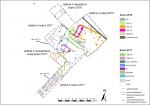Summary (English)
The excavation of the upland late Bronze Age settlement of Monte Croce is carried out by Rome University in collaboration of CNR and ISMA.
The 2017 campaign added a great deal to knowledge of the settlement’s internal spatial organisation. In particular, the excavation of the large rectangular hut (sector 4; hut 4.1), partially investigated in 2016, was completed. The structure was orientated north-east/south-west and presents rock-cut foundation channels and a central row of postholes, probably to support the roof. It covers a surface area of about 10 × 4.5 m (45 m2) and was flanked by a small parallel channel situated at 1.5 m to the west, perhaps for a portico or enclosure on one of the long sides.Further west another rectangular structure (hut 4.4) came to light. It was smaller (6 × 3.5m), but also had rock cut channel foundations. The lack of archaeological deposit, except for the fill in the channels and postholes, makes it impossible to establish a stratigraphic relationship between this hut and the others identified in the same sector during the 2016 season. For the same reason, the finds were also scarce. Therefore, hut 4.4 cannot be definitely dated to one of the construction phases identified in 2016, although its parallel alignment to hut 4.1, relating to the first construction phase of the succession that developed in sector 4 suggests the two structures could be contemporary.
Several rows of postholes were also found in the same area of sector 4, probably relating to palisades and other structures. One of the rows can be interpreted as a long palisade, whose series of postholes is partially interrupted by the channel of the proposed portico of hut 4.1 and therefore predates it. Other alignments form squares perhaps for structures that did not have channel foundations.
The archaeological deposit was better preserved towards the western part of the sector, where the excavation has not been completed. However, the archaeological materials, both ceramic and bronze, indicate a Final Bronze Age date, somewhere between the initial and the mature phase.
A trench 22 m long and 4 m wide (sector 5) was opened alongside sector 4, which reached the western edge of the Monte della Guardia plateau. The excavation was not completed and will continue next season. However, a series of terraces and small walls situated about 3 m one from the other were uncovered, which relate to the structuring of the plateau’s edge. A larger wall was also partially exposed close to the plateau’s edge.
Here, the deposit was constituted by a thick colluvial layer containing Late Bronze Age materials and a few fragments of coarse ware pottery, probably Roman. Below this thick layer, the stratigraphy relating to the structural evidence was constituted by a deposit attributable to the early and full Final Bronze Age.
The intention for the next campaign is to clarify the nature of the structural evidence and ascertain whether it constitutes a system of delimitation and fortification for the site, or rather an organization limited to a specific part of the settlement.
- Andrea Cardarelli, Sapienza Università di Roma
- Andrea Di Renzoni- CNR-ISMA
- Marco Bettelli- CNR-ISMA
Director
- Andrea Cardarelli, Sapienza Università di Roma
- Andrea Di Renzoni- CNR-ISMA
- Marco Bettelli- CNR-ISMA
Team
- Cristina Tavolini, Sapienza Università di Roma
- Fabiana Macerola Sapienza Università di Roma
Research Body
- Sapienza Università di Roma
Funding Body
- Comune di Arcevia
- Sapienza Università di Roma






![Download [PDF]](/excavation/skins/fasti/images/results/download_sml.png)